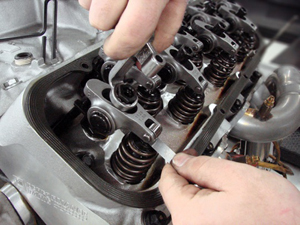By David Vizard
All too often the effect of valve lash on power output is considered very much a secondary factor and a small one at that. This may be so, but the ramps open the valves relatively slowly and during that period the flow, into and out of the cylinder, is little more than a nuisance leak and this almost always manifests itself as a reduction in torque throughout the rpm range.

Let me throw a simple concept at you here based on what the dyno tells us. The torque output of an engine always improves when the rate of change of flow presented to the cylinder is increased both at the point of opening and closing. What this means is that fast opening and closing works so long as the mechanical dynamics don’t get out of bounds. All this means that setting the valve lash toward the loose end of the scale usually produces better results.
Often times I see fundamental mistakes made when lashing valves on an engine that has been equipped with higher ratio rockers than stock. Just recently while working with a now retired ProStock engine builder such a situation came up. The engine concerned was a 555 cid big block Chevy (the data from which I will be using in my upcoming BB Chevy performance book Vol. II). For this motor I had ported a set of Darin Morgan’s 320 cc oval port street heads. With optimized lash and a regular 1.8/1 intake rocker this motor made 808 hp on 87 octane fuel. The lash that made best power was at the wide limit not tight.
At this point I thought the engine could make 825 hp so 808 was off the mark. Our next move here was to install a set of 1.8/1 rockers that had geometry that produced a higher ratio (about 1.99/1) during the early phase of opening. With the lash set as before the engine lost power all the way up to the last four numbers around the peak power mark (6,500 to 6,800 rpm). Down around 3,000 rpm the torque was down by as much as 17 ft.lbs. The mistake made here was that the lash was set exactly as it was before the rocker change.
When we set lash at the valve what we are really doing is setting the lash at the lifter and the rocker ratio plays into this. If the tappet ramp is say 0.010˝ high on the lobe then the lifter reaches the true start of tappet lift after having moved 0.010˝ up from the base circle. If a 1.5/1 rocker is involved then the lash setting will be 0.010˝ x 1.5 which equates to 0.015˝. However if we step up that rocker ratio to say 1.7 then the lash to get the identical opening point will be 0.010˝ x 1.7 which works out to 0.017˝ not the original 0.015˝.
For our 555 big block Chevy the optimal hot lash with stock ratio 1.7/1 rockers was 0.018˝. With regular 1.8/1 rockers having an off the seat ratio right around the nominal 1.8 the optimum hot valve lash was 0.019˝. Our fast off the seat rockers produced almost 2/1 coming off the seat. This required the lash to be set at 0.021˝.
So how well did the fast off the seat rockers work? Well for a chronically under-valved engine such as the big block Chevy having faster intake opening can pay seemingly disproportionate dividends. But opening the intake faster alters the point of optimal cam advance. Our cam timing had been optimized for the 1.8/1 regular rockers by means of a Jesel belt drive. With the cam retarded just about one degree and the higher off the seat ratio rockers torque went up over the entire tested rpm range and peak power rose to 824.6 hp. Close enough to our target output.
At 6,800 rpm the output was up by over 30 hp and the average low to mid range torque was up over 20 ft.lbs. over that with an incorrectly set lash. Just so you realize this is a true street big block Chevy (and a relatively low buck one at that) this output was achieved on 87 octane fuel and the engine would idle at 680 rpm. If you are not a big block Chevy expert you will almost certainly find my new big block Chevy book (Vol I) a boon toward out-powering your competition and how to do it while being very cost competitive. Just go to amazon.com and search David Vizard books, or click here.
If you have a real thirst for power and want to know considerably more about power enhancing valve train moves (and a whole lot of everything else), then I suggest you come along to my Goodson/Engine Builder Magazine two day How to Build Horsepower seminar being held at Myron Cottrell’s TPI Specialties in Chaska, MN, on Saturday and Sunday, September 10-11. For more details or to register, visit www.davidvizardseminars.com.













